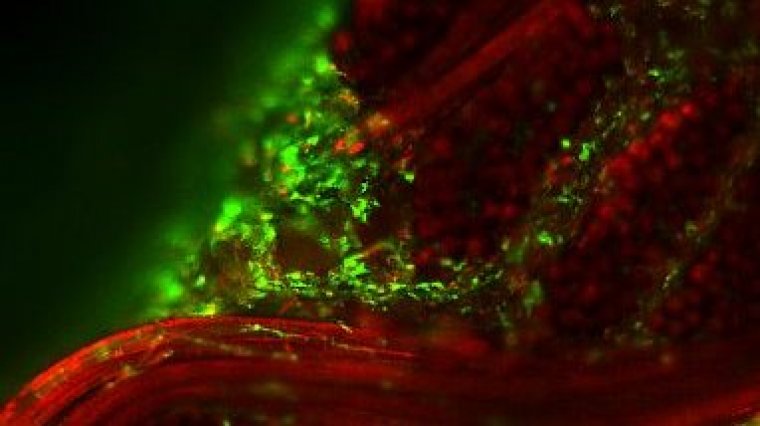| Health / Health News |
Stem cells grown on scaffold mimic hip joint cartilage
NIH | AUGUST 14, 2016
A team from Washington University School of Medicine in St. Louis, previously engineered a scaffold to guide stem cells into cartilage-producing cells. The group set out to build on this work by incorporating a gene transfer approach to induce cells to produce an anti-inflammatory compound to prevent further joint degradation.

Stem cells (stained green) grew throughout the pores of the scaffold (stained red). ![]()
A layer of smooth cartilage lines the ends of the bones in many joints in the body. The cartilage has special properties that enable it to absorb energy, bear weight, and lubricate the joints so they can function seamlessly. In osteoarthritis, this cartilage breaks and wears away. Bones under the cartilage may then rub together, causing pain, swelling, stiffness, and disability.
Treatments include exercise, medications to control pain, and surgery to reposition or resurface the joint or to replace it with an artificial one. Restoring the cartilage in these joints would be an important advance in the treatment of osteoarthritis.
The scientists formed 3-D woven textile scaffolds from a biomaterial. The 22-mm scaffolds were shaped over a mold to mimic a hip joint surface and attached to a nylon mesh to maintain their shape. The mechanical properties of the scaffolds could be altered by varying the weave architecture.
Adult human fat-derived stem cells obtained from liposuction waste were seeded onto the outer surface of the porous scaffolds. The cells and scaffolds were maintained in tissue culture for 38 days. During this time, the cells grew to evenly cover the scaffolds. They produced a matrix made up of proteins, such as collagens, that are key components of joint cartilage. The matrix created a smooth, glistening appearance over the scaffolds.
The scientists next engineered a harmless virus to contain a gene with instructions to make the anti-inflammatory molecule IL-1 receptor antagonist (IL-1Ra). They attached this viral vector to the scaffolds and then added the stem cells, which attached and grew. When they added a chemical to the culture media to turn on the gene, the cells produced high levels of IL-1Ra. When inflammatory molecules were added to the cultures, the IL-1Ra prevented the production of a joint-damaging protein.
YOU MAY ALSO LIKE



